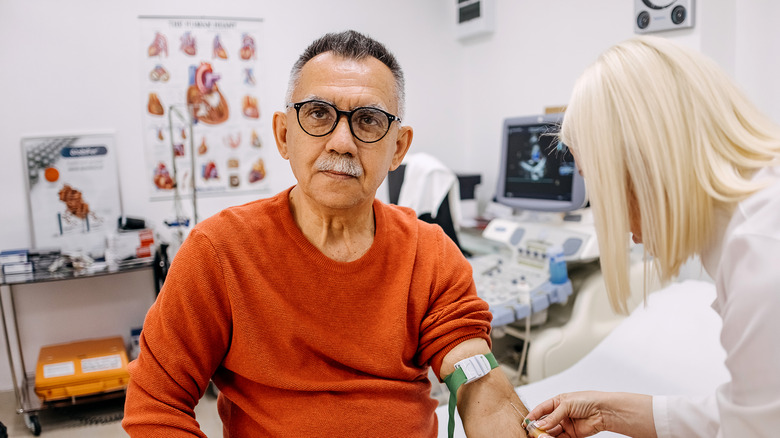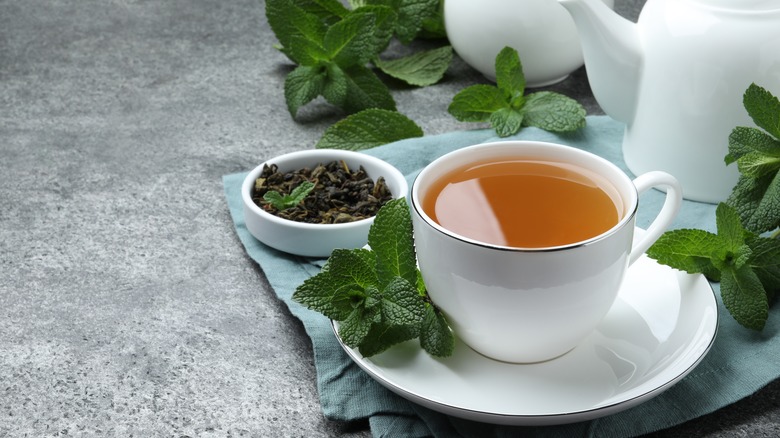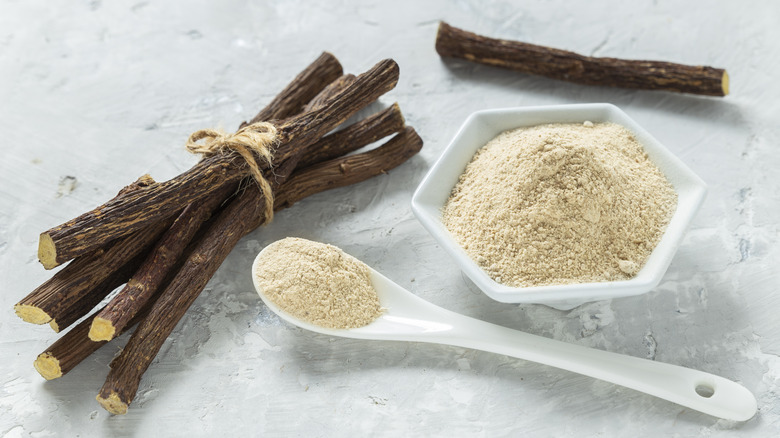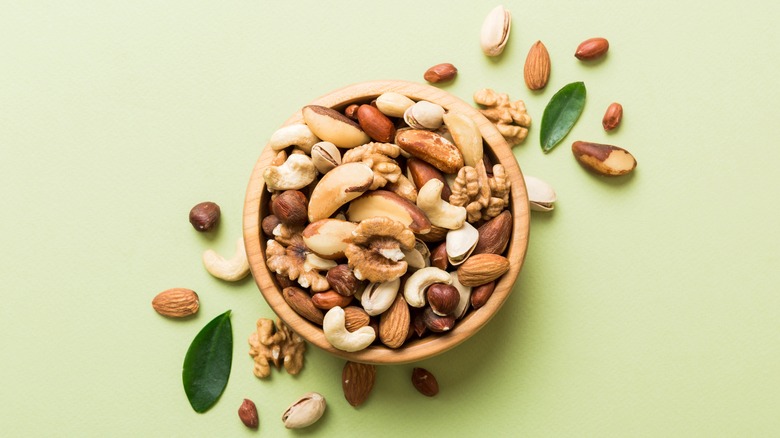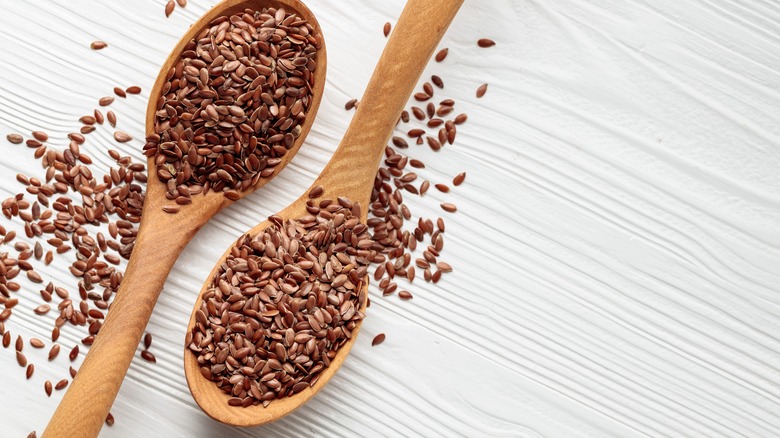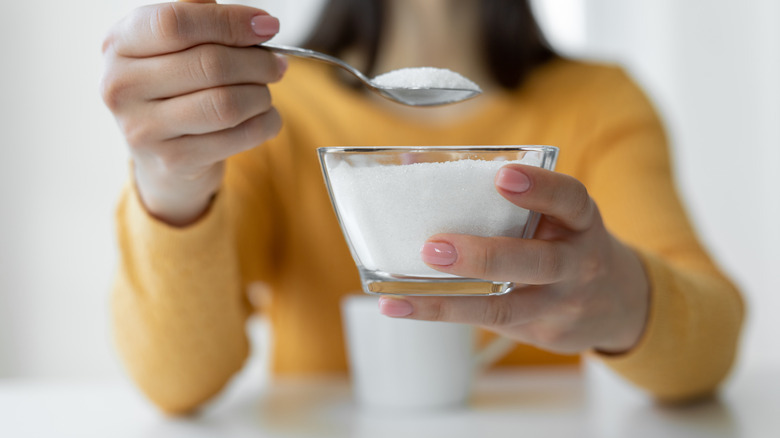Healthy (And Unhealthy) Foods That Will Actually Kill Your Testosterone
Testosterone is a sex hormone primarily produced in the testes of people assigned male at birth (AMAB). However, it is also produced in the ovaries of people assigned female at birth (AFAB) and the adrenal glands of both sexes. It plays a crucial role in the development and maintenance of male reproductive organs and masculine characteristics, such as the growth of facial and body hair, deepening of the voice, and muscle mass development. Beyond its influence on physical traits, testosterone also impacts libido, bone density, sperm production, and mood regulation in people AMAB. In people AFAB, it is thought to play roles in ovarian function, bone density, and libido (via Harvard Health Publishing).
While a yearly reduction in testosterone levels in people AMAB is expected as part of the aging process, some may have low testosterone levels at any age. According to the American Urological Association (AUA), the normal range for blood testosterone levels is 450–600 nanograms per deciliter; and total testosterone levels below 300 nanograms per deciliter lead to a testosterone deficiency diagnosis.
Per the Cleveland Clinic, low testosterone (also known as male hypogonadism) is a condition that affects people with testicles. It happens because the testicles produce too little of this hormone, which can significantly impact physical and emotional well-being.
The site explains that, while the condition cannot really be prevented, leading a healthy lifestyle can help manage your testosterone levels. This includes eating healthy foods and avoiding excessive alcohol intake (among others). However, it's not just unhealthy foods and drinks that can kill your testosterone levels. Believe it or not, some healthy foods may also hinder your efforts to keep your testosterone levels in check. Keep reading to find out which healthy and unhealthy foods you should avoid if you're dealing with low testosterone.
Causes and risk factors for low testosterone levels
Understanding the causes and risk factors for low testosterone levels is essential in guiding diagnostic efforts and developing appropriate treatment plans. According to the Mayo Clinic, causes for low testosterone levels can be divided into primary and secondary. Since testosterone is produced in the testicles, the primary causes are those that directly affect them. This may include conditions such as Klinefelter syndrome (a genetic disability that causes abnormal development of the testicles), testicles that aren't descended at birth, mumps orchitis (a viral infection involving the testicles), hemochromatosis or high blood iron levels, testicular injuries or damage (especially if both testicles are affected), and cancer treatments like radiation therapy and chemotherapy.
As for secondary causes, the site explains that these are the ones that affect the hypothalamus or the pituitary gland, two parts of the brain that control how much testosterone your testicles produce (meaning that while the testicles are fine, they're not getting the signals needed to make the hormone). These causes often include Kallmann's syndrome (a genetic disorder affecting the hypothalamus), brain tumors in or near the pituitary gland (and their respective treatments), inflammatory diseases of the hypothalamus and the pituitary gland (like sarcoidosis, histiocytosis, and tuberculosis), certain medications, HIV and/or AIDS, obesity, and aging.
Low testosterone levels symptoms and complications
Low testosterone levels can lead to various symptoms and potential complications, affecting both physical and emotional well-being. While you may associate this condition with fewer masculine characteristics, the truth is that signs and symptoms of low testosterone levels vary greatly depending on when the condition develops, which can happen anytime from the womb to adulthood. According to the Mayo Clinic, symptoms of low testosterone during fetal development can lead to underdeveloped sex organs, causing babies AMAB to have either female, ambiguous, or underdeveloped male genitals. In contrast, low testosterone during puberty or adolescence can hinder the development of common masculine traits, such as voice deepening and the growth of body and facial hair, muscle mass, and external sex organs.
When testosterone levels drastically decline during adulthood, the site explains that it can lead to reduced sex drive or decreased interest in sexual activity, persistent fatigue, and difficulties with memory and concentration. Plus, it can lead to physical symptoms such as loss of muscle mass, increased body fat, reduced growth of facial and body hair, and even gynecomastia (the growth of breast tissue). The physical and emotional symptoms of low testosterone can significantly impact a person's overall quality of life, affecting relationships, self-esteem, and general well-being. Moreover, since testosterone helps maintain bone density, low levels can lead to complications such as an increased risk of osteoporosis, making bones more susceptible to fractures. It can also cause infertility; emotional changes, including increased irritability and mood swings; and erectile dysfunction (difficulties in achieving or maintaining erections).
Mint
Studies conducted on women with polycystic ovary syndrome (PCOS) have found that mint may possess anti-androgen effects. Androgens are male sex hormones, such as testosterone. In contrast, anti-androgens are compounds or drugs that bind to androgen receptors in the body to block their effects (via Healthline). The excessive presence of androgens in women with PCOS can lead to various symptoms such as acne, excessive facial or body hair growth (hirsutism), and male-pattern hair loss (per Mayo Clinic); and, according to a 2007 study published in Phytotherapy Research, drinking spearmint or peppermint tea regularly has been associated with reductions in free testosterone levels in women with PCOS.
In fact, per the study, doctors in Turkey had already noticed that drinking spearmint or peppermint tea led to diminished libido or sexual desire, which is a common symptom of low testosterone levels. Researchers in the study confirmed these effects after giving spearmint tea twice a day for five consecutive days to 21 women with hirsutism and noticing a significant decrease in free testosterone levels. They went as far as suggesting that spearmint can be a possible substitute for anti-androgenic treatment for mild hirsutism. Similarly, another 30-day study of 41 women with PCOS published in the same journal in 2010 found the same results. Nevertheless, it's important to note that these are older and smaller studies; and, therefore, more research is needed to validate these effects.
Trans fats
You probably already know that trans fats are bad for you thanks to the harmful effects they have on your heart and metabolic health. But did you know that they may also lower your testosterone levels? Trans fatty acids (or trans fats, for short) are artificially produced fats commonly found in processed foods, fast foods, fried foods, and some baked goods (per American Heart Association (AHA)). According to a 2017 study published in the Asian Journal of Andrology, the consumption of trans fats has been linked to lower total testosterone levels in people AMAB, primarily because of their negative impact on testicular function, as well as their effect in reducing testicular volume. When testicular function is impaired, testosterone production can be reduced, potentially leading to various associated health issues.
Similar results were found in another 2014 study published in the journal Human Reproduction. This time, the study determined that a high trans fats intake from french fries and commercially baked items can negatively affect male reproductive health in various ways. Aside from reducing blood testosterone levels, it can lead to reduced fertility, fewer healthy sperm, and impaired sperm movement and shape. In severe cases, it may even cause the production of sperm to stop, and the testicles may start to deteriorate. Therefore, it is safe to say that avoiding an excessive trans fats intake and adopting a well-rounded, nutritious diet can play a vital role in maintaining healthy testosterone levels and overall well-being.
Licorice Root
Licorice root is a plant known for its various medicinal properties, but it contains compounds that may lead to a reduction in testosterone levels in both healthy men and women. Per a 2021 review published in Heliyon, one such compound is glycyrrhizin, which can interfere with an enzyme called 11-β-HSD that plays a role in the metabolism and synthesis of androgen hormones. In short, this enzyme is responsible for converting androgenic steroids into testosterone. So, by slowing it down or reducing its activity, less testosterone is produced, leading to lower levels of testosterone in the blood.
Several studies have explored the effects of licorice root on testosterone levels. For example, a 2004 study published in Steroids that included nine healthy women found that consuming licorice daily during the luteal phase of two menstrual cycles led to a drop of 32% in testosterone levels during the first month, plus an additional 5% reduction during the second month. Similarly, a 2020 article found in "Textbook of Natural Medicine" shared the results of a study of healthy men who consumed the equivalent of 500 milligrams of glycyrrhizin from licorice root and reported a reduction of 26% in their total testosterone levels.
Nuts
Nuts offer numerous health benefits, such as being rich in antioxidants, fiber, vitamins, and minerals. They are also known to promote heart health and may help manage weight when consumed in moderation as part of a balanced diet. Yet, some nuts may impact testosterone levels due to their effects on the levels of sex hormone-binding globulin (SHBG). As its name implies, SHBG is a protein that binds to sex hormones such as testosterone in the bloodstream, rendering it inactive and unavailable for use by the body's tissues. Thus, when SHBG levels are too high, more testosterone is bound to it, resulting in lower levels of free or active testosterone (via WebMD). According to a 2011 study published in the European Journal of Clinical Nutrition, a daily intake of 31 grams of fat from walnuts for six weeks in women with polycystic ovary syndrome (PCOS) led to a 12.5% increase in SHBG levels, resulting in anti-androgenic effects that lowered testosterone levels.
Moreover, nuts may also lower testosterone levels due to their composition of polyunsaturated fatty acids (PUFAs). PUFAs are a type of healthy fat found in nuts, seeds, fish, and certain oils (via Medical News Today). According to an older 2000 study published in the journal Nutrition and Cancer, consuming unhealthy and healthy fats (including PUFAs) was inversely associated with blood testosterone levels, meaning that higher intakes resulted in lower levels.
Flaxseed
Flaxseed, a small but powerful seed, has been studied for its potential impact on testosterone levels, primarily because of its omega-3 fatty acid and lignan content. Omega-3 fatty acids are a type of healthy fat known for their various health benefits, including reducing inflammation and supporting heart health (via the National Institutes of Health Office of Dietary Supplements (NIH)); and, according to a 2013 study published in the Iranian Journal of Reproductive Medicine, omega-3 fatty acids may have a suppressive effect on testosterone levels. Per the study, omega-3 fatty acids may reduce testosterone levels due to their impact on luteinizing hormone (LH). LH is a hormone that regulates your reproductive system, and in people AMAB, it promotes testosterone production (via the Cleveland Clinic). Therefore, by reducing LH levels, omega-3 fatty acids in flaxseed also lower testosterone levels.
Moreover, a 2007 study published in the journal Current Topics in Nutraceutical Research explains that, with levels that are 800 times higher than those found in most other foods, flaxseed is one of the richest sources of lignans, which are plant compounds with estrogen-like properties (via ScienceDirect). Per the study, lignans in flaxseed may have anti-androgenic effects that can reduce the levels of testosterone circulating in the blood. Researchers believe this happens because lignans increase the levels of SHBG, which consequently leads to a reduction in testosterone levels.
Alcohol
Research has explored the potential impact of alcohol consumption on testosterone production. Still, the findings have been mixed; and the relationship is not entirely straightforward. On the one hand, research suggests that alcohol may have adverse effects on testosterone levels, particularly with heavy or chronic alcohol consumption. Per a 2019 study published in the Journal of Clinical Medicine, heavy drinkers are more likely to have poor testicular function than moderate alcohol consumers. This is because chronic or long-term alcohol intake can cause testicular damage; but also its acute or short-term intake can have a negative effect on the hypothalamus-pituitary axis, leading to disruptions in hormone regulation, including testosterone production. In addition, alcohol can harm the liver, which plays a crucial role in metabolizing hormones, including testosterone.
On the other hand, an older 2003 study published in Alcohol: Clinical and Experimental Research found that moderate alcohol consumption may actually slightly increase testosterone levels in healthy individuals. Similar results were found in a 2003 animal study published in the same journal. Nevertheless, while said studies have suggested potential links between alcohol and higher testosterone levels, it is important to note that this research is still very limited and dated, so it would be best not to draw definitive conclusions based on these.
As with any dietary or lifestyle consideration, moderation is key. And keep in mind that alcohol consumption can lead to a range of health issues beyond hormonal effects, including liver damage, heart problems, and dependence (per World Health Organization (WHO)).
Vegetable oils
Vegetable oils, commonly used in cooking and food processing, contain high levels of PUFAs. PUFAs are considered healthy fats because they have numerous benefits for your heart health, such as reducing your blood cholesterol levels, which lowers your risk of heart attacks and stroke (per AHA). However, some research suggests that consuming excessive amounts of PUFAs from vegetable oils may be associated with reduced testosterone levels.
In one 2019 study published in Nutrients, researchers found that men with obesity who consumed 52 grams of PUFAs from soybean oil experienced a significant fall in testosterone levels that lasted up to five hours after the meal, suggesting a negative impact of this type of fats on total testosterone levels. Interestingly, the study states that there is no impact on blood testosterone levels when providing PUFAs intravenously (through a vein), which implies that PUFAs don't directly affect the cells that produce testosterone. Instead, the passage of fat through the intestines might be what causes a reduction in testosterone production in a dose-dependent manner (meaning that it is directly linked to how much fat is consumed). Therefore, considering the association between the suggested effects and the amount of PUFAs consumed in the study and taking into account the positive effects of PUFAs on your overall health, consuming them in moderation rather than eliminating them from your diet may be the best option.
Sugar
It is no secret that diets high in sugar are not the healthiest for you, but research also suggests that high-sugar diets have been linked to lower testosterone levels. According to a 2022 study published in the International Journal of Molecular Sciences, high blood sugar levels tend to be accompanied by a reduction in testosterone levels. Similar results were found in a 2018 study published in Reproductive Biology and Endocrinology, which determined that sugar intake has immediate effects that can lower total and free testosterone levels in men.
This second study evaluated the effects of testosterone levels after consuming sugar-sweetened beverages (SSBs), seeing that they are the primary source of added sugars in the American diet. Besides finding that excessive SSB intake is significantly associated with low testosterone levels, the study also noted that it strongly contributes to weight gain and obesity, which is another factor associated with reduced testosterone levels. So, while having sugary drinks or treats occasionally and in moderation is not likely to cause significant changes in your testosterone levels, a regular intake of sugary foods and drinks as part of an unhealthy diet could lead to long-term health problems, like hormonal imbalances and even fertility problems.
Therapy options for low testosterone levels
When it comes to treating low testosterone levels, there are various testosterone replacement therapy (TRT) methods available that can be tailored to fit your specific needs. However, if an underlying medical condition causes testosterone levels to drop, treating that condition would be the first line of action to help restore testosterone levels. For example, if there's a pituitary gland issue, addressing the problem in the gland may help normalize testosterone production (via Harvard Health Publishing).
According to the site, TRT involves administering testosterone to the body to bring hormone levels back within a healthy range. With TRT, testosterone can be administered through different methods, including weekly or biweekly injections, daily oral capsules or topical gels, 24-hour skin patches, and intradermal pellets, which are implanted under the skin to slowly release the hormone and can last from three to six months. The chosen method depends on the individual's preferences and lifestyle factors, and it can alleviate the most common low testosterone symptoms, such as low libido and fatigue, within the first six weeks of treatment. However, a 2015 study published in The Aging Male states that TRT should be closely monitored by a healthcare provider to avoid potential side effects, seeing that its long-term safety and effectiveness are still highly debated within the medical community.
Benefits and risks of testosterone replacement therapy
TRT aims to bring hormone levels back to what they should be in young adults. It's supposed to mimic the body's natural production of the hormone and, thus, improve quality of life. Therefore, it is known that TRT has numerous benefits to offer. According to a 2009 review published in the journal Therapeutics and Clinical Risk Management, some of these potential benefits include improved sexual desire, function, and performance by enhancing libido and alleviating erectile dysfunction; improved bone density in people with osteoporosis; increased muscle mass and strength; enhanced mood and well-being by improving energy levels and reducing symptoms of depression; improved cognitive performance, including memory, spatial abilities, and mathematical reasoning; reduced risk of anemia; and an overall improvement in the components of the metabolic syndrome (obesity, high blood pressure, high cholesterol levels, impaired glucose regulation, and insulin resistance).
Nevertheless, the review explains that TRT may also come with some associated health risks, which can appear depending on age, life circumstances, and other medical conditions. Some of the potential downsides for TRT include the development of prostate cancer due to its nature as a hormone-sensitive disease; liver problems, such as toxicity or tumors; increased risk of heart diseases due to a spike in hemoglobin levels (red blood cells that carry oxygen to your tissues); reduced testicular size and fertility issues; gynecomastia; sleep apnea; hormonal imbalances, resulting in adverse effects like acne, fluid retention, or mood swings; excessive libido and aggression; and skin reactions to the application site.
Some people want to lower their testosterone levels
While some people may benefit from avoiding foods that can lower their testosterone levels, others, such as non-binary people and transgender women, may seek to lower their testosterone levels as part of their gender-affirming journey. According to a 2019 article published in the journal Current Problems in Pediatric and Adolescent Health Care, people with non-binary gender identity may identify with varying degrees of masculinity or femininity and, therefore, may experience different degrees of dissatisfaction with certain parts of their body. In this case, people AMAB may experience dysphoria with their masculine characteristics and may be interested in feminizing their appearance to align with their gender identity. The same goes for transgender women, or people AMAB that identify and live as women.
According to the Mayo Clinic, some non-binary and transgender women choose to undergo feminizing hormone therapy (also called gender-affirming hormone therapy), a medical intervention designed to help align their physical characteristics with their gender identity. In this type of hormonal therapy, people typically take anti-androgen medications alongside estrogen supplementation, which work to block or suppress the effects of testosterone, thus decreasing masculine physical features and feminizing their bodies. Per the Boston University School of Medicine, a common goal of hormone therapy is to lower testosterone levels to the typical range found in cisgender women (30–100 nanograms per deciliter).


